|
|
|
Sort Order |
|
|
|
Items / Page
|
|
|
|
|
|
|
| Srl | Item |
| 1 |
ID:
126411
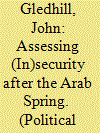

|
|
|
|
|
| Publication |
2013.
|
| Summary/Abstract |
More than two years after the heady days of protest and uprising that characterized the Arab Spring, the glow of revolution has given way to the intricacies and complications of regime building. Coalitions are being formed, constitutions written, judiciaries vetted, and security services (re)built. As collective attention focuses on these complexities of regime restructuring, it is worth noting that a fundamental security paradox sits at the heart of transitions in the Middle East and North Africa. On one hand, individuals who hit the streets or battlefields in support of revolution in 2011 did so in the belief that a new form of government would improve their political, social, and economic security over the long term. On the other hand, subsequent (and ongoing) efforts to draft new rules of the political game have triggered internal conflicts and, on occasion, those conflicts have compromised citizens' physical security over the short term.
|
|
|
|
|
|
|
|
|
|
|
|
|
|
|
|
| 2 |
ID:
114810


|
|
|
|
|
| Publication |
2012.
|
| Summary/Abstract |
The international community has many reasons to promote compromise between the parties to internal conflicts. Yet to do so effectively, the international community ought to treat principled rather than strategic compromise as its default position. To make this case, we begin by defining 'compromise' and by distinguishing principled from strategic compromise. We then defend the idea of principled compromise against the realist who thinks that that idea is implausible. We conclude by offering a number of practical reasons why principled compromise ought to be preferred. Our argument does not deny that strategic compromise will sometimes be the only option. But, unlike principled compromise, strategic compromise does not provide the parties with any particular reason to look beyond their own particular concerns or to give any ground beyond what is absolutely necessary.
|
|
|
|
|
|
|
|
|
|
|
|
|
|
|
|
| 3 |
ID:
099476
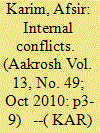

|
|
|
| 4 |
ID:
115915
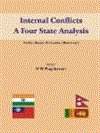

|
|
|
|
|
| Publication |
New Delhi, Vij Books India Pvt Ltd, 2013.
|
| Description |
ix,274p.
|
| Standard Number |
9789382573883
|
|
|
|
|
|
|
|
|
|
|
|
Copies: C:2/I:0,R:0,Q:0
Circulation
| Accession# | Call# | Current Location | Status | Policy | Location |
| 056912 | 303.60954/RAG 056912 | Main | On Shelf | General | |
| 057049 | 303.60954/RAG 057049 | Main | On Shelf | General | |
|
|
|
|
| 5 |
ID:
090126
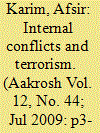

|
|
|
|
|
| Publication |
2009.
|
| Summary/Abstract |
The US and North Atlantic Treaty Organisation (NATO) forces are engaged in a deadly combat with a conglomeration of jihadis in Afghanistan, and the conflict is likely to intesify in the near future with the induction of additional U.S. forces. The outcome of war is uncertain as the adversaries are engaging the coalition forces in a kind of warfare in which military victory is not easy because it is a conflict in which the resources of two belligerents differ in essence and in the struggle, interact and attempt to exploit each other's characteristics weaknesses.
|
|
|
|
|
|
|
|
|
|
|
|
|
|
|
|
| 6 |
ID:
128391
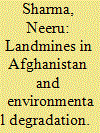

|
|
|
|
|
| Publication |
2011.
|
| Summary/Abstract |
The politico-military conflicts are constant in history. These politico-military conflicts have been deeply entrenched in human society. century has been the biggest producer of war and conflicts victims. All major wars and politico- military con?icts of the twentieth century, including the conflicts in Afghanistan, have one hidden causality and, that is, environment. Amid politico-military conflicts, brutality, death and deprivation, environment may seem a minor causality but actually by which new expectations can be formed.' The vast majority of armed conflicts today are not traditional wars between states or coalitions of states, but rather internal conflicts.
|
|
|
|
|
|
|
|
|
|
|
|
|
|
|
|
| 7 |
ID:
175205
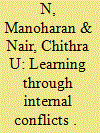

|
|
|
| 8 |
ID:
130180
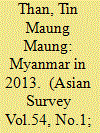

|
|
|
|
|
| Publication |
2014.
|
| Summary/Abstract |
The year 2013 in Myanmar saw parliaments disagreeing with the executive. A joint parliamentary committee to review and amend the Constitution was formed. Western sanctions were virtually withdrawn. A resurgence of communal violence, the emergence of Buddhist nationalism, and public protest over mega-projects, land rights, wage disputes, and freedom to demonstrate were worrisome developments. A nationwide ceasefire agreement remained elusive.
|
|
|
|
|
|
|
|
|
|
|
|
|
|
|
|
| 9 |
ID:
075746
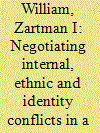

|
|
|
|
|
| Publication |
2006.
|
| Summary/Abstract |
How, under current conditions, do negotiators find a resolving formula that is enticing to the parties in internal conflicts and that lasts? The search for an answer about this process can take three paths: One that focuses on the context provided by the conflict itself, another that examines the content of the appropriate outcome, and a third that looks at the conduct of parties in their negotiating roles. A particular challenge comes from the internal and international reactions - primarily Islamic - to the encroachment of globalization into their area, where the challenge is to move the conflict from non-negotiable to negotiable. A wide range of conflicts will be used to illustrate the conceptual discussion.
|
|
|
|
|
|
|
|
|
|
|
|
|
|
|
|
| 10 |
ID:
126014
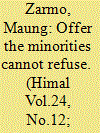

|
|
|
|
|
| Publication |
2011.
|
| Summary/Abstract |
In his Manifesto of the Communist Party (1848), Karl Marx wrote: 'The history of all hitherto existing society is the history of class struggles.' Such an assessment is only half-right when it comes to Burma's internal conflicts, of which ethnicity is of equal importance to class. Whether ethnicity is largely a matter of 'political choice', as many academics suggest today, has little relevance in the lives of these ethnic peoples. The Karen, Kachin, Mon, Shan, Karenni and others have chosen to hold on to their AK-47s or M16s in order to fight on. The unappealing alternative is surrender and subjugation at the feet of their uncompromising enemy in Rangoon and, since 2005, Naypyidaw.
|
|
|
|
|
|
|
|
|
|
|
|
|
|
|
|
| 11 |
ID:
071625
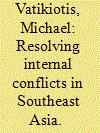

|
|
|
|
|
| Publication |
2006.
|
| Summary/Abstract |
This article examines a number of armed conflicts in Southeast Asia and draws out common threads of causality and impact. First, it is argued that internal conflicts continue to afflict the region and act as an obstacle to political reform. Next, the slow process of conflict resolution is highlighted and several reasons stated for why this is the case. The example of Southern Thailand is highlighted to show how poorly some of these conflicts are being managed. Finally, several suggestions are made to help policy-makers in the region improve the process of conflict resolution.
|
|
|
|
|
|
|
|
|
|
|
|
|
|
|
|
| 12 |
ID:
130095
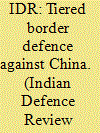

|
|
|
|
|
| Publication |
2014.
|
| Summary/Abstract |
On balance, the prospects of Sino-Indian conflict remain. What appears certain is that China's aggressive stance and the initiation of conflict will be aimed at undermining India's status as a regional power. It India tails to respond adequately, she will be projected as a 'Soft State' susceptible to coercion. Simultaneously, the Chinese aim would be to keep India embroiled in lighting internal/regional conflicts. In doing so, China may be expected to virtually abrogate any agreements such as Border Peace and Tranquility Agreement and Confidence Building Measures and BDCA leading to incremental build up and conflict.
|
|
|
|
|
|
|
|
|
|
|
|
|
|
|
|
| 13 |
ID:
133582
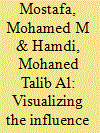

|
|
|
|
|
| Publication |
2014.
|
| Summary/Abstract |
The aim of this paper is to investigate why some internal conflicts are terminated quickly, while others linger for several decades without a looming resolution in the horizon. In an attempt to achieve this objective, the role played by geopolitical factors in the Arab world's internal conflicts was investigated. More specifically, we used Kohonen self-organizing maps, an artificial intelligence-based neural network technique, along with event duration models to investigate the role played by distance from the capital, access to international borders, terrain, valuable natural resources such as oil, and rebels fighting capability in civil wars in the Arab world. Using recently validated data spanning more than 50 years of Arab civil wars (1948-2003), our findings indicate that previously ignored geopolitical factors seem to play an important role in the duration of internal conflicts in the Arab World.
|
|
|
|
|
|
|
|
|
|
|
|
|
|
|
|
| 14 |
ID:
161213
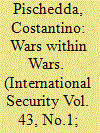

|
|
|
|
|
| Summary/Abstract |
Why do rebel groups often fight each other when confronting a common, and typically stronger, enemy—namely, the government? Inter-rebel aggression is a calculated response by rebel groups to opportunities for expansion and to the threats confronting such groups. In particular, inter-rebel wars occur under the following conditions: (1) when a window of opportunity emerges allowing rebel groups to defeat coethnic rivals at low costs and thus achieve rebel hegemony, or (2) when rebel groups are confronted with a window of vulnerability, in which they experience a radical deterioration of power relative to that of coethnic rivals and then attempt to escape in a desperate military gamble. Both strict military considerations and ethnic identities shape the rebel groups' calculus. Coethnicity influences the threat perception of rebel groups and their ability to grow at the expense of rivals, thus providing both defensive and offensive motives for inter-rebel aggression. Because coethnic rebel groups want to mobilize and control the same ethnic communities, they are highly sensitive to immediate, intense conflicts of interest and see other coethnic rebel groups as serious threats. Moreover, coethnic rebel groups can generally expect to absorb the resources of defeated rivals, which in turn may improve their chances in the fight against the government. In-depth case studies of multiparty insurgencies in Ethiopia's Eritrea and Tigray provinces, based on interviews with former rebel leaders, strongly support the window of opportunity and vulnerability theory of inter-rebel war.
|
|
|
|
|
|
|
|
|
|
|
|
|
|
|
|
|
|
|
|
|